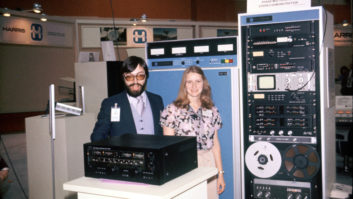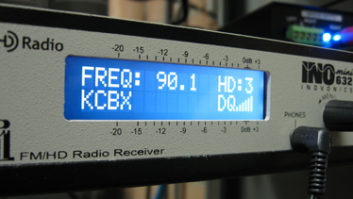The summer of 2003 was not the quite the summer of love Ibiquity Digital had been expecting.
At the NAB show this spring, company officials said they hoped to help stations using its HD Radio system promote their digital sound in towns across America – think HD Radio Beach promotions.
Instead, the momentum behind IBOC practically ground to a halt when the standards-setting body, the National Radio Systems Committee, stopped its vetting process for HD Radio. Leaders of the NRSC found the audio quality produced by Ibiquity’s PAC codec not good enough for broadcast on AM at low bit rates.
In May, the NRSC stopped standards setting for the technology for both AM and FM.
What a difference a few months can make.
Now Ibiquity has a new codec called HDC. The leaders of the NRSC and its DAB subcommittee have heard it and say they’re impressed. They have agreed to resume the standards-setting process, which the FCC eventually will use to develop final authorization rules for IBOC digital radio.
Some U.S. radio stations continued to convert to HD Radio during the pause.
‘Resolved’
“Nobody is happier than I am to see the codec issue resolved,” said DAB Subcommittee Chairman Milford Smith. He said recent private demos of Ibiquity’s system incorporating the new codec were well-received by steering committee members.
Ibiquity and other IBOC proponents hope to regain momentum lost during the “pause” toward commercializing HD Radio.
Skeptics say Ibiquity isn’t out of the woods yet; they feel the technology developer lost some credibility with the industry because it took so long for the company to focus on the codec issue and because it dismissed roughly 30 employees, including several of its top engineers.
Critics also note that Ibiquity has not released technical details of its new codec; and as yet there is no public data to back up the claims of improved performance of HDC over AAC on AM.
The layoffs were reportedly made for cash-cutting reasons. The Columbia, Md., company has declined to discuss personnel issues publicly.
Ibiquity must stretch its cash for long enough to launch the product, sources say. One broadcast engineer said the company may require two years of income from fees on receiver sales before it will realize substantial revenue from the technology.
Ibiquity President/CEO Robert Struble said reports of the company needing more cash are incorrect.
“Our cash position is solid,” he said, adding that the company has enough money to take it well beyond the first quarter of next year.
Yet several broadcasters told Radio World privately that Ibiquity is seeking more radio groups as investors. The recent codec demos are key to that plan, said sources.
Ibiquity has conducted private demos for engineers of several large groups and some station managers. It declined to provide a list, but demos reportedly included Clear Channel, NPR, Susquehanna, Journal Broadcast and other major radio organizations.
One source with a group that has not yet invested in Ibiquity said, “It was like, ‘Show me the codec.'”
Certainly the codec issue cost Ibiquity in terms of time to market. New codec software is expected to ship to its chip partners by mid-September.
Stations first
Kenwood hopes to be first to market with manufactured HD Radios. Earlier this year it had expected to ship receivers to retailers in the summer. After the news of the new codec, the company said it expected to ship HD Radios to stations that are on-air with Ibiquity’s technology this month and in limited quantities to certain retailers in the fourth quarter. The Kenwood radios were not yet assembled as of mid-August.
Ibiquity was to deliver codec software upgrades to chip partners S.T. Microelectronics, Texas Instruments and Philips, so the chipmakers could upgrade the software on their chips and make them available to receiver manufacturers for HD Radios.
Kenwood plans to make a big splash at the CES show in January with its 2004 HD Radios and to be able to ship significant quantities of product that month. Kenwood also plans to introduce a home version in the first quarter of 2004.
Vice President of Kenwood USA Bob Law said the codec change has required only software changes in receivers, not modifications in hardware. This means the “pause” and its aftermath will be invisible to consumers.
Yamaha postponed earlier plans to release home receivers for HD Radio in 2003 due to the pause.
Visteon plans to include HD Radios in a European automaker’s products in model year 2005 are on track. Those autos would come out in the last half of 2004 to the first quarter of 2005, said a spokeswoman.
Bill Wikehart, a DSP specialist with Visteon, said many automakers are interested in HD Radio.
Delphi reportedly delayed plans to ship HD Radios in 2003 for some model year 2004 cars. Attempts to reach Delphi for comment were unsuccessful.
HDC jointly developed
The HDC coded is unique and proprietary to Ibiquity, according to President and Chief Executive Officer Robert Struble. He and some industry sources say the codec is not aacPlus, nor is it PAC. Other believe it could be a custom version of aacPlus.
Ibiquity Chief Operating Officer Jeff Jury said HDC makes use of AT&T Bell Labs core patents. Ibiquity now holds the rights to the patents related to this codec, the result of the earlier marriage of USADR to Lucent Digital Radio.
HDC has been customized for AM and FM broadcasters and to work with the Ibiquity system.
Coding Technologies Vice President and U.S. General Manager David Frerichs said the Spectral Band Replication technology used in the codec helps Ibiquity “hit the bit rate efficiencies they were looking for.” He said the new codec has a bit rate resiliency that makes it suited for AM and FM broadcasting.
Coding Technologies says its Spectral Band Replication technology is part of the Digital Radio Mondiale open standard and a core object type of MPEG-4 Audio.
Some questions remain about the performance of the new codec. Engineers who have heard it were careful to note that on AM, artifacts are not eliminated fully. They have however been substantially reduced – so much so that, they say, the system is acceptable for broadcast.
Ibiquity plans to re-do some of its tests with the new codec and submit the results to the NRSC.
The NRSC reviewed Ibiquity test results using the previous codec, AAC, with both FM and AM. Ibiquity intended to redo certain tests when it switched to PAC. It submitted, then withdrew those results earlier this year, intending to try again with a newer version of PAC. Then the NRSC announced its standards pause.
The new codec will be used for both AM and FM, Ibiquity said, although the NRSC had no complaint with PAC used on FM.
And where does this leave PAC, Ibiquity’s former codec? Ibiquity intends to support PAC because it still has a customer for the codec, Sirius. A spokesman for the satellite company said Sirius intends to keep using PAC.
Although much of the PAC team in Warren, N.J., is no longer with Ibiquity, roughly five employees who work with PAC remain, said sources.












